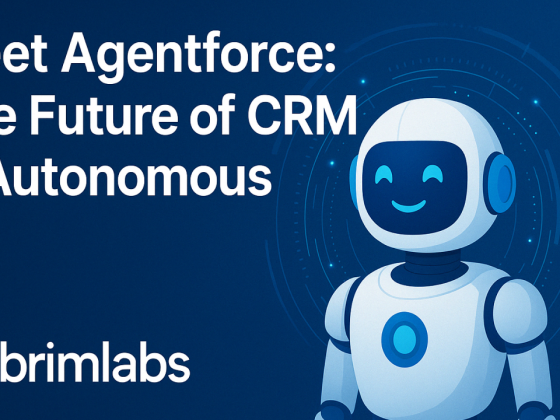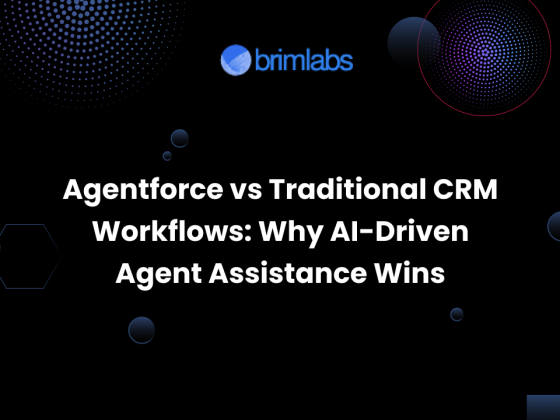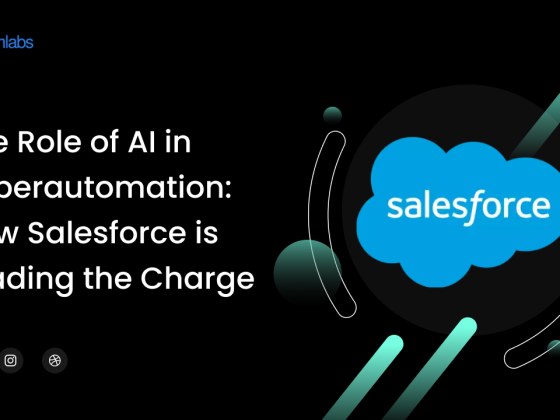Automation is the use of technology to carry out operations or tasks with the least amount of human involvement. It makes it possible to streamline and manage labour-intensive, repetitive operations effectively, which decreases errors, boosts productivity, and saves time.
Automation in the context of business and IT can take many different forms. For example, it might refer to straightforward processes like automatically responding to emails or more intricate workflows involving the interaction of several systems.
What is Automation in Salesforce?
Automation is the practice of employing software tools to streamline business processes and repetitive tasks in order to minimise errors, increase productivity, and reduce manual labour. Within the Salesforce framework, automation facilitates more efficient customer relationship management for enterprises by automating repetitive processes such as creating tasks, allocating leads, sending emails, and updating records—all without requiring human participation.
Task assignments, record updates, notifications, approvals, and other duties may all be automated with the help of Salesforce’s robust automation features. Increasing productivity, maintaining data consistency, and freeing up users to concentrate on more worthwhile tasks are the objectives.
Salesforce Automation Tools
Salesforce offers multiple tools for automating tasks, each serving different levels of complexity. The main automation tools available in Salesforce include:
1. Workflow Rules
Salesforce Workflow Rules are an effective automation tool that let you automate basic business procedures. By starting processes like field updates, emails, task creation, or outgoing messages depending on predetermined criteria, they lessen the need for manual labour. This guarantees efficiency and uniformity in daily activities.
Key Components of Workflow Rules:
Criteria: These are the circumstances under which a workflow rule ought to be activated. You can establish criteria, for instance, depending on record fields, dates, or particular statuses.
Actions: After the requirements are satisfied, steps are taken. Four sorts of activities are supported by workflow rules:
Email Alerts: Send users or outside recipients an email automatically.
Field Updates: Modify a record’s field value.
Task Creation: Give users assignments to complete and monitor.
Outbound Messages: Transmit data to an external system via outgoing messages.
The Operation of Workflow Rules:
- Triggering Event: Depending on the parameters you specify, the rule is activated whenever a record is created or changed.
- Instantaneous Actions: When the rule’s requirements are satisfied, quick actions take place, such as emailing someone or updating a field.
- Time-Dependent Actions: Workflow rules have the ability to initiate time-dependent actions, such as sending an email reminder seven days prior to a contract expiration.
2.Process Builder
Salesforce’s Process Builder is a potent point-and-click tool that can automate intricate business procedures more flexible than Workflow Rules. Without creating any code, it enables users to automate numerous tasks on various objects within a single process.
Key Features of Process Builder:
Multiple Criteria: Process Builder has the ability to assess several criteria and carry out distinct actions in response to those conditions, in contrast to Workflow Rules, which are limited to one action per rule. This implies that you can construct intricate logic with multiple solutions.
Numerous Actions: Process Builder facilitates a number of actions, such as:
- Create Records: Automatically create new records, such tasks or opportunities, based on particular parameters.
- Update linked Records: This method offers more flexibility than workflow rules by updating information on linked records in addition to the triggering record.
- Send Email Alerts: Notify users or outside parties by email automatically.
- Post to Chatter: Notify teams of critical updates by posting messages to a Chatter stream.
- Submit for Approval: As part of a formal review procedure, submit records for approval.
- Launch Flows: Start a Salesforce Flow, allowing for more advanced automations and user interactions.
User-Friendly Interface: Admins may easily design automations without coding experience thanks to the drag-and-drop interface. Processes with distinct decision pathways and actions can be visually built, which facilitates management and understanding.
Time-Based Actions: Process Builder, like Workflow Rules, has the ability to plan actions, such delivering follow-up tasks or reminders, to happen at a specific time or date in the future.
The Operation of Process Builder:
- Triggering Event: A platform event or the creation or modification of a record start the procedure.
- Evaluation of Criteria: Salesforce assesses the record in relation to the parameters you’ve specified. The procedure will move on to the following stage if the requirements are satisfied.
- Execute operations: Process Builder can carry out a number of operations, including as adding new records, sending notifications, and modifying fields, in accordance with the criteria.
3.Salesforce Flows
One of Salesforce’s most potent automation technologies, Salesforce Flow makes it simple for users to create intricate workflows. With its greater flexibility and control over Workflow Rules and Process Builder, Flow makes it possible to create dynamic, multi-step automations that involve user interactions. Admins may change records, automate operations, and even walk users through on-screen wizards using this no-code solution.
Key Features of Salesforce Flow:
Two Types of Flows:
- Screen Flows: These flows let users engage with the system by directing them through a procedure step-by-step using on-screen prompts.
- Autolaunched Flows: These flows don’t need human input; instead, they operate in the background automatically in response to specific events or criteria.
Drag-and-drop Interface: Flow offers a visual builder, akin to Process Builder, where users can create complicated workflows without writing any code by dragging and dropping objects like loops, decisions, and update records.
Advanced Logic and Actions:
- Decisions: Depending on the circumstances, flow may diverge into other directions.
- Loops: These let you update all opportunities associated with an account or carry out repetitive operations on a group of records.
- Record Manipulation: Flow offers greater power than other automation tools because it can create, update, delete, or search for records in any object.
- Calling Apex: You can call custom Apex code directly from within a flow in even more complex scenarios.
Data and External System Interaction: Flow is a potent tool for integrations since it can communicate via APIs with external systems in addition to working with Salesforce data.
How Salesforce Flow Works:
- Trigger Event: Flows can be programmed to run at a specific time or they can be set to run automatically upon the creation, modification, or deletion of a record.
- Flow Elements: Flows are made up of components that tell Salesforce what to do, like loops, decisions, and record updates.
- User Input (for Screen Flows): If users are involved in the flow, the system will lead them through a sequence of screens while gathering data and displaying pertinent information.
- Automation of activities: Flow will carry out the specified activities, such as updating records, notifying users, or directing them, based on the input and conditions.
Benefits of Automation
- Enhanced Productivity: By eliminating the need for repetitive processes and human data entry, automation frees up time so teams can concentrate on high-value work.
- Enhanced Accuracy: By guaranteeing data consistency and lowering human error, automated procedures enhance the accuracy of information stored in Salesforce.
- Scalability: Organisations can handle massive amounts of data and procedures thanks to automation, which eliminates the need for corresponding increases in labour.
- Faster Decision-Making: By triggering timely activities like approvals and alerts, automation systems help reduce bottlenecks and speed up decision-making.
- Enhanced User Experience: Users can simplify complex operations and enhance their overall user experience by using guided processes that are made possible by interactive automations such as Screen Flows.
How to Implement Automation in Salesforce
1.Identify Processes for Automation
- Analyse business procedures that are error-prone, time-consuming, or repetitive first. These make excellent automation candidates.
- Lead assignment, approval processes, email alerts, and data updates are typical examples.
2.Choose the Right Automation Tool
Select the right tool for the job based on its complexity:
- Simple processes: use Process Builder or Workflow Rules (if available).
- Complex processes: For managing decision trees, multi-step logic, and system integration, use Salesforce Flow.
3.Define Criteria and Actions
- Clearly state the circumstances in which automation should occur. For instance, when the status of a lead is updated or when an opportunity reaches a particular point.
- Specify what needs to be done, such as adding a task, sending an email, or amending a field.
4.Test Automation
- Before sending the automation to production, test it in a Salesforce Sandbox environment to make sure it works as intended and doesn’t interfere with other operations.
5.Monitor and Optimise
- Once implemented, monitor the performance of your automated processes. Seek chances to streamline by merging several procedures into more effective Flows or getting rid of pointless stages.

Conclusion
Salesforce automation may significantly improve organisational efficiency by reducing human labour, streamlining procedures, and increasing productivity. Utilising tools such as Salesforce Flow, Process Builder, and Workflow Rules, organisations can streamline intricate procedures and enable staff members to concentrate on what really matters—establishing and maintaining strong client connections and achieving success.
Businesses should assess their current procedures and transition to more scalable, flexible solutions as Salesforce strengthens its automation tools, emphasising Flow as the preferred option. Using automation to your Salesforce setup not only saves time but also positions it for future growth and innovation.
Get in touch with us right now for a free consultation on deploying Salesforce Flow and other automation solutions customised for your company if you’re prepared to increase productivity and simplify your business operations using Salesforce automation!











